26
DecExploring Azure Cloud Services: From Setup to Success
Azure Cloud Services, offered by Microsoft, is a platform that helps developers and businesses to create, manage, and deploy applications in the cloud without the need for physical servers. Azure Cloud Services provides tools for hosting websites, storing data, running apps, and even advanced tasks like AI and machine learning.
In the Azure Tutorial, we will take a closer look at Azure Cloud Services, including key features of Azure Cloud Services and a lot more. For students, it’s a great way to practice coding, test projects, or build applications efficiently, all in a virtual space that's easy to access and scale. Azure is powering 40% of global cloud infrastructure. Don’t get left behind—enroll in our Free Microsoft Azure Fundamentals Online Training today!
What is Azure Cloud Service?
Azure Cloud Services is a Microsoft platform that lets you build, deploy, and manage apps in the cloud without needing physical servers. It provides a virtual space to run applications, store data, and use advanced tools, making it easier and more scalable than managing everything yourself. Simply put, Azure Cloud Services helps you work in the cloud, not on your hardware.
Key Features of Azure Cloud Services
Azure Cloud Services offers a range of features that make it a powerful and flexible platform for building, managing, and scaling applications. Here are some of its key features:
- Scalability: Azure Cloud Services allows you to easily scale your resources up or down, depending on the needs of your application, without any hassle.
- Security: It provides strong security measures, like encryption and access controls, to keep your data safe in the cloud.
- Cost-Effective: You only pay for what you use, which makes it an affordable choice for businesses and students alike.
- Reliability: Azure offers high availability, meaning your applications are less likely to go offline, ensuring smooth operations.
- Flexibility: You can choose from a wide variety of services to customize your cloud environment based on your specific needs.
- Global Reach: Azure has data centers all over the world, so you can deploy your applications close to your users for faster performance.
- Easy Integration: Azure Cloud Services easily integrates with other Microsoft products, like Office 365 and Power BI, making it simple to work across different tools.
Types of Azure Cloud Services
Azure Cloud Services offers three main types of cloud service models, each designed for different needs. These are
- Infrastructure as a Service (IaaS),
- Platform as a Service (PaaS), and
- Software as a Service (SaaS).
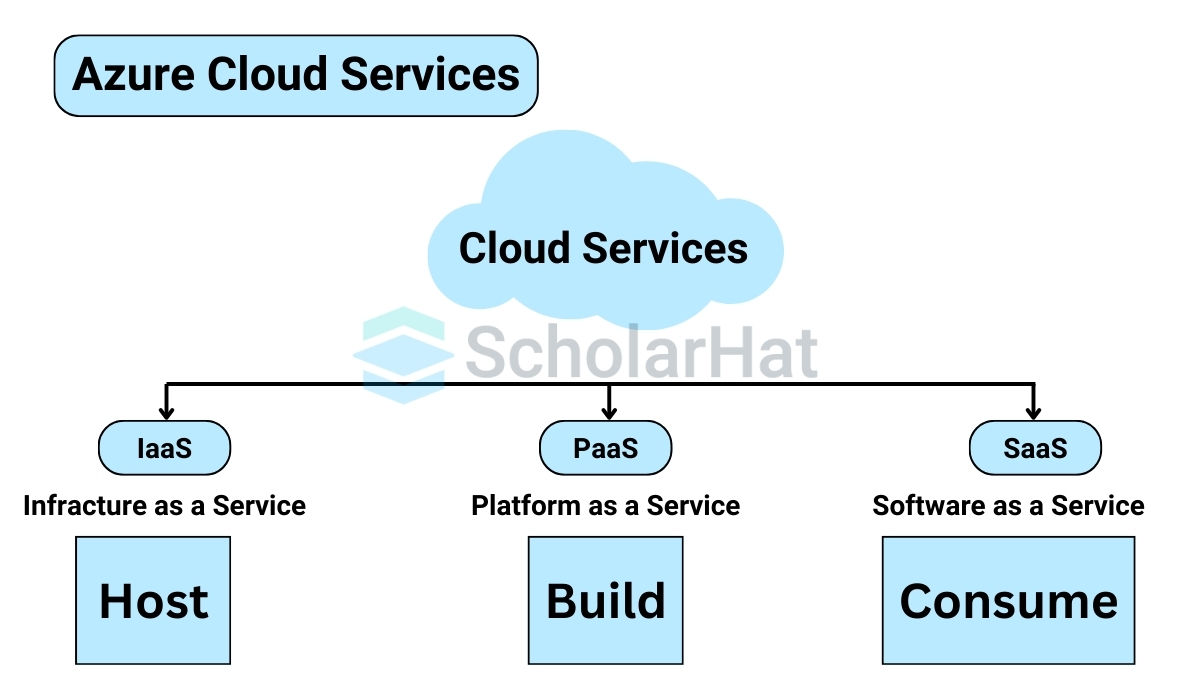
1. Infrastructure as a Service (IaaS)
With IaaS, Azure Cloud Services provides you with virtualized computing resources over the internet. This means you can rent Azure virtual machines, storage, and networks without the need to buy or maintain physical servers. It's like renting a fully-equipped computer system in the cloud to run your applications.
2. Platform as a Service (PaaS)
Azure Cloud Services also offers PaaS, which gives you a platform to develop, run, and manage applications without worrying about the underlying infrastructure. It handles things like server maintenance and software updates, so you can focus purely on coding and application development.
3. Software as a Service (SaaS)
With SaaS, Azure Cloud Services delivers software applications over the internet, so you don’t need to install or maintain them on your own devices. Examples include apps like Microsoft 365 or Google Workspace. With SaaS, you can access your software from anywhere, and Azure takes care of the rest, including updates and security.
Each of these types of Azure Cloud Services caters to different needs, allowing businesses and developers to choose the best fit for their projects.
Roles in Azure Cloud Services
Azure Cloud Services involves different roles, each with its own responsibilities. Here’s a breakdown of these roles in simple terms:
1. Cloud Administrator
Azure Cloud Administrator takes care of the overall setup and management of Azure. They make sure everything is running smoothly, set up security, and keep an eye on the system to prevent problems.
2. Cloud Developer
Azure Cloud Developers are the ones who create and build the apps that run on Azure. They write the code, add features, and make sure the apps work well on the cloud platform.
3. Cloud Architect
Azure Cloud architects design the structure of the system on Azure. They figure out what tools and services are needed and how to organize everything to meet business needs in a smart and affordable way.
4. Security Engineer
Azure Security engineers make sure the data and apps in Azure are safe from threats. They set up protections like Azure firewalls and encryption and manage who can access the system.
5. Cloud Analyst
Azure Cloud analysts check how well everything is working on Azure. They look at the data, find any issues, and suggest ways to improve the system to save costs or make it run better.
These roles work together to keep Azure Cloud Services running effectively, securely, and efficiently.
Components of Azure Cloud Services
Azure Cloud Services has several key components that work together to help you build, manage, and run applications smoothly. Here are the main parts:
1. Virtual Machines (VMs)
These are like computers in the cloud. You can run operating systems and applications on them without needing physical hardware. They let you create and manage servers without the hassle.
2. Azure Storage
Azure provides different types of storage, such as Azure Blob Storage for files and Azure SQL Database for data. You can safely store data and access it from anywhere, anytime, while Azure takes care of backups and security.
3. Azure Networking
This is what connects your resources together. It includes tools like Azure Virtual Networks, VPNs, and Azure Load Balancers that help you securely link different parts of your system and manage traffic flow.
4. Azure App Services
This component helps you build and deploy web apps, mobile apps, and APIs easily. Azure takes care of the infrastructure, so you can focus on the application itself.
5. Azure Active Directory
It’s a service that helps manage user identities and access. It ensures that only authorized users can access the resources in your Azure environment, adding an extra layer of security.
6. Azure Functions
This is a serverless computing service that lets you run code without worrying about servers. You can write small pieces of code that trigger automatically in response to specific events.
7. Azure Kubernetes Service (AKS)
If you’re working with containers (small, portable software packages), Azure Kubernetes Service (AKS) helps you manage and deploy them on Azure. It simplifies container management by automating much of the process.
These components work together to give you a flexible, scalable, and secure cloud environment where you can build, deploy, and manage everything from small apps to large enterprise systems.
Step-by-Step Guide to Set up Azure Cloud Services Using Azure Portal
Step 1. Click on "Create a resource" and then enter "Cloud Service" in the search box.
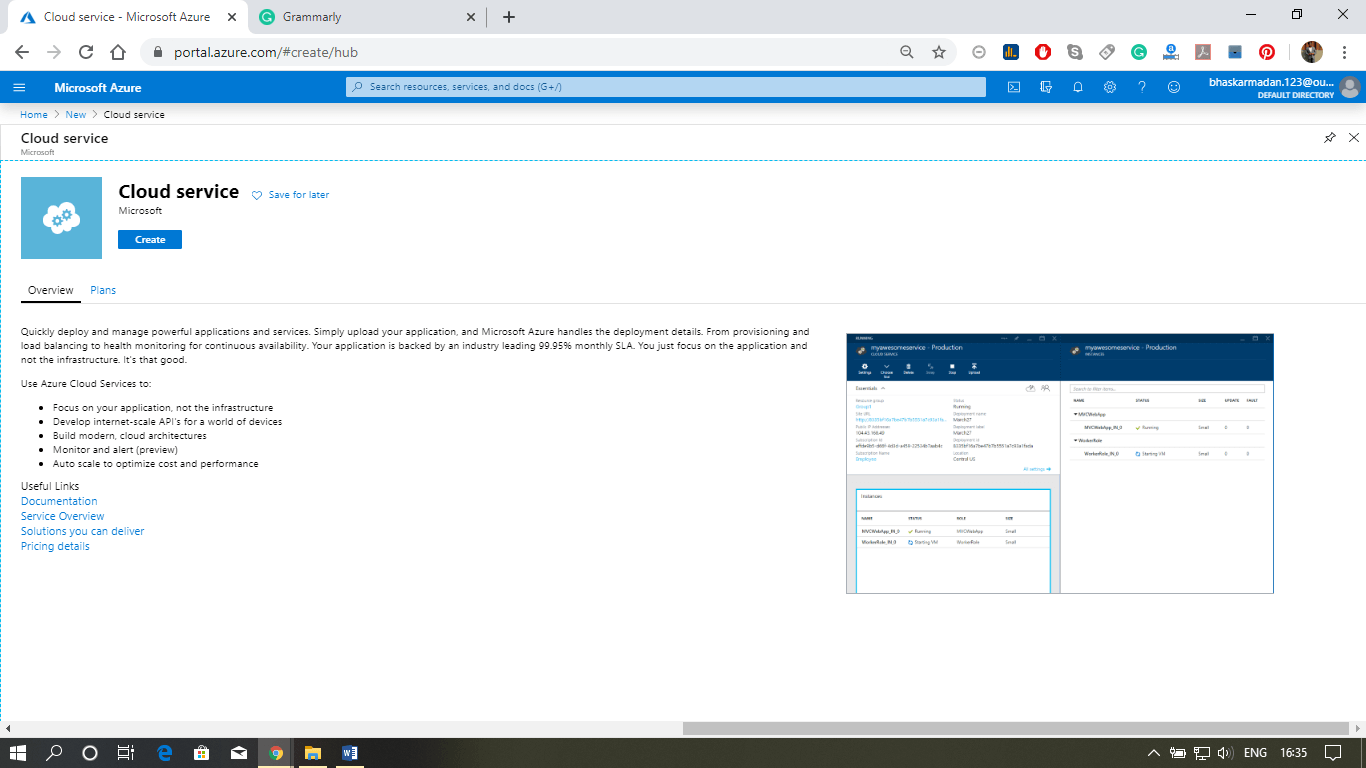
Step 2. After that, select it and then click on the "Create" button.
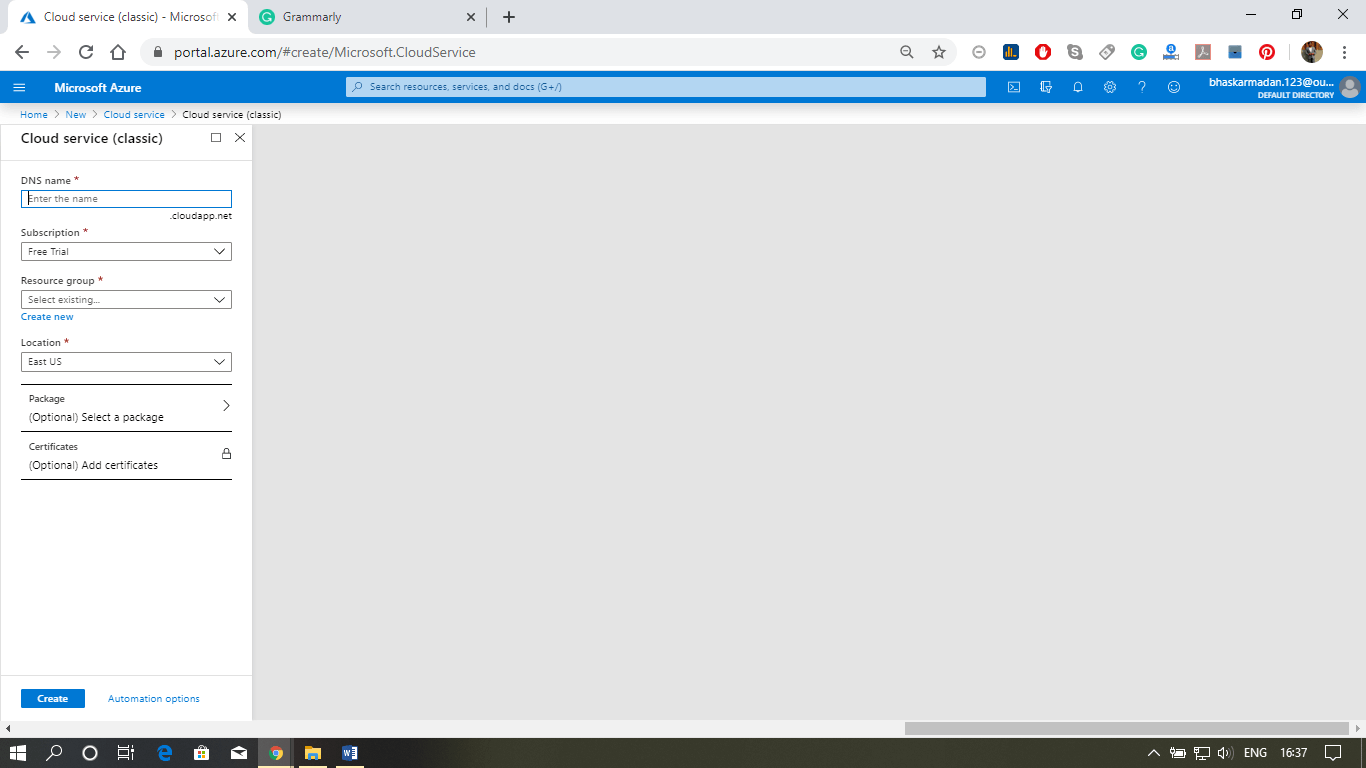
Step 3. Enter the DNS name, choose the resource group, and select the location.
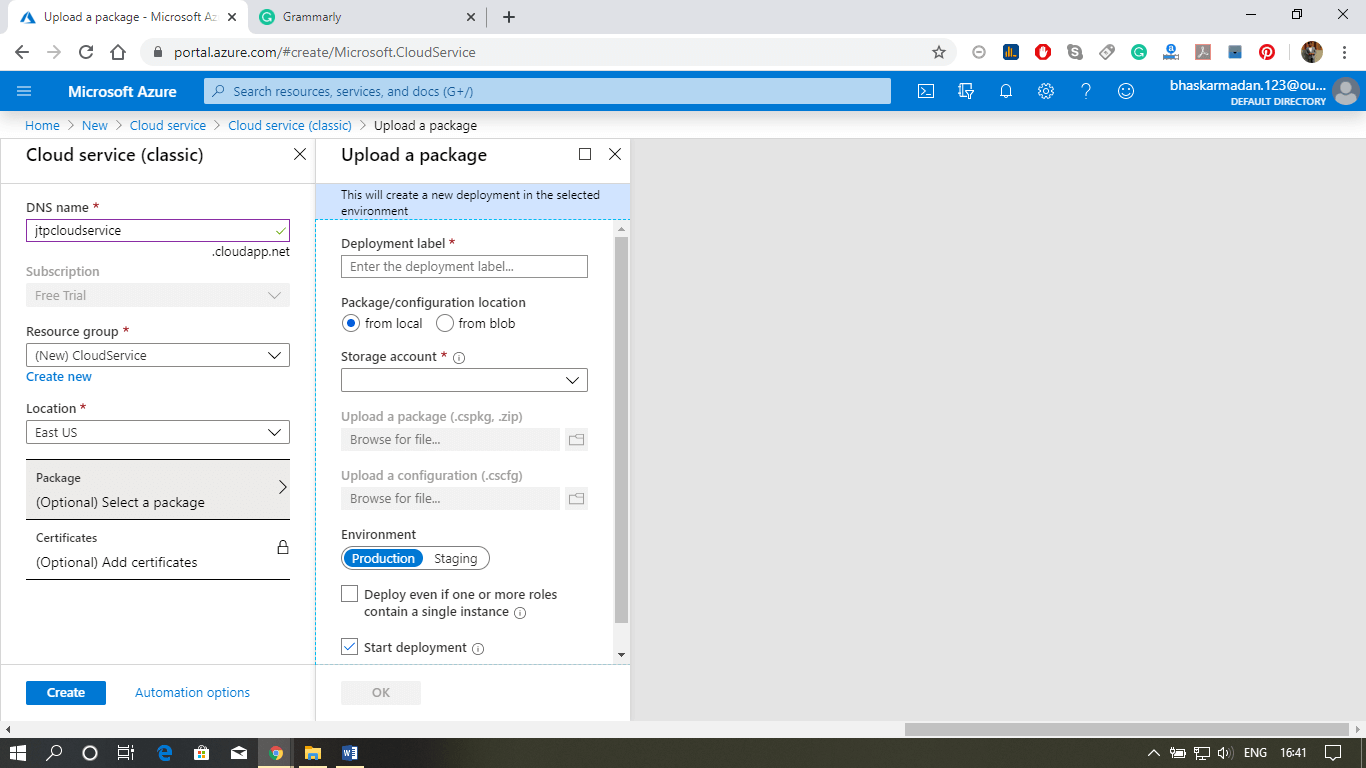
Step 4. Now, click on "Create" to begin the creation of your cloud service.
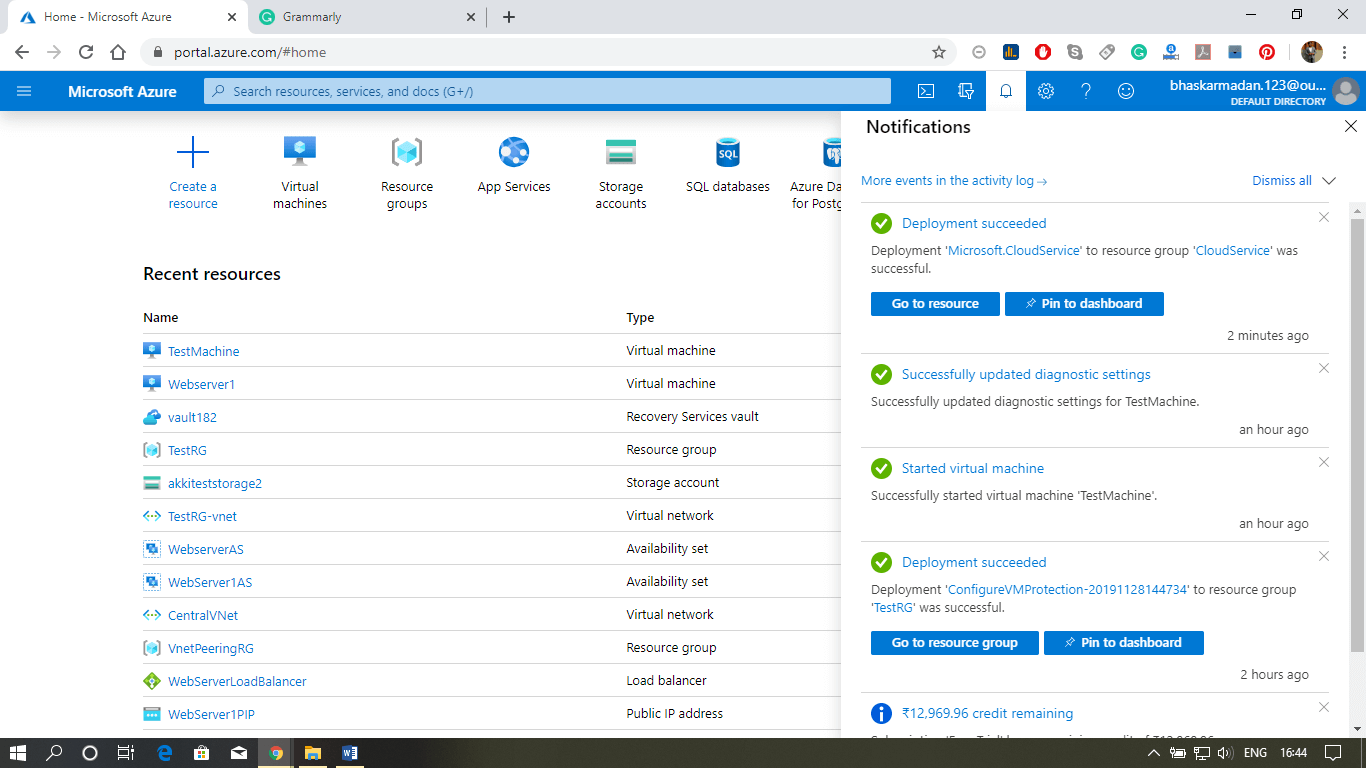
Step 5. To access the cloud service, click on "Go to Resources."
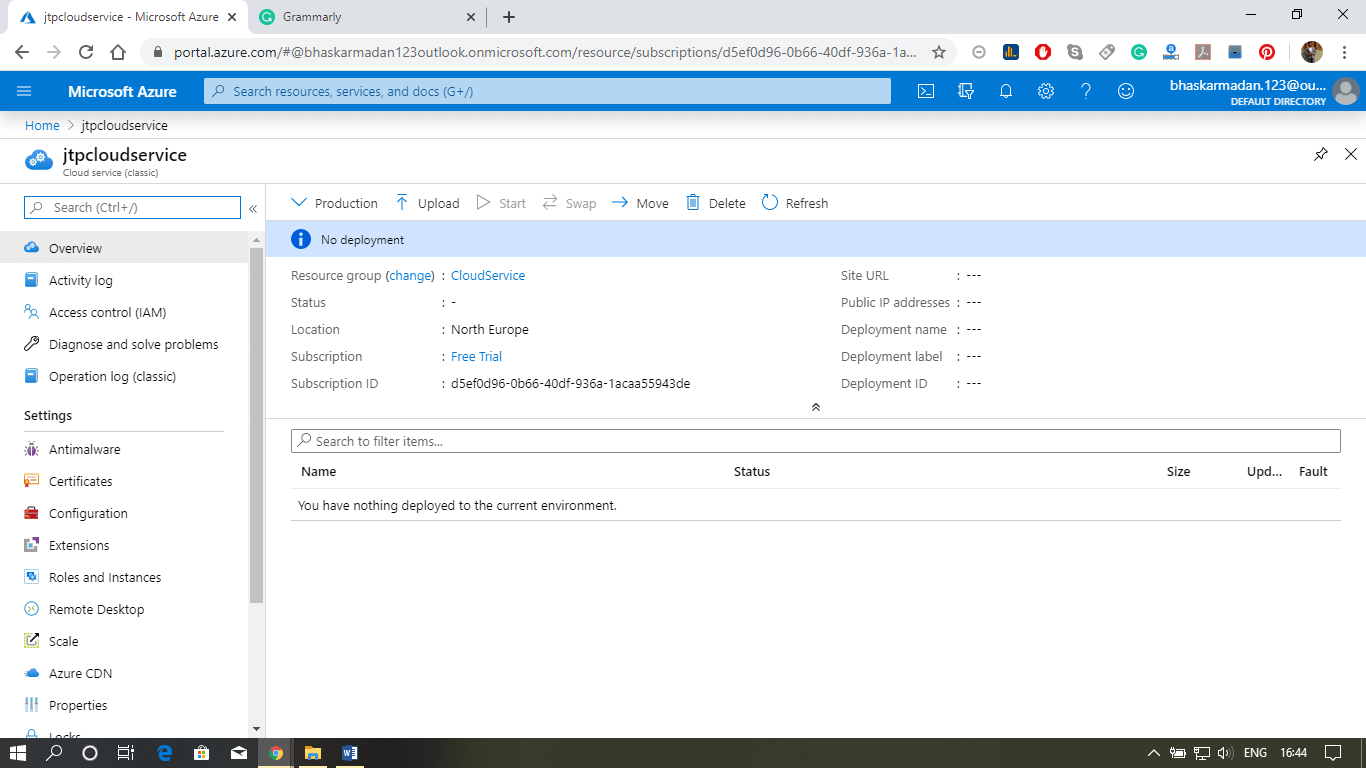
Step 6. Now, open Visual Studio and create a new cloud service project. You will find the basic configuration settings displayed, as shown in the image below.
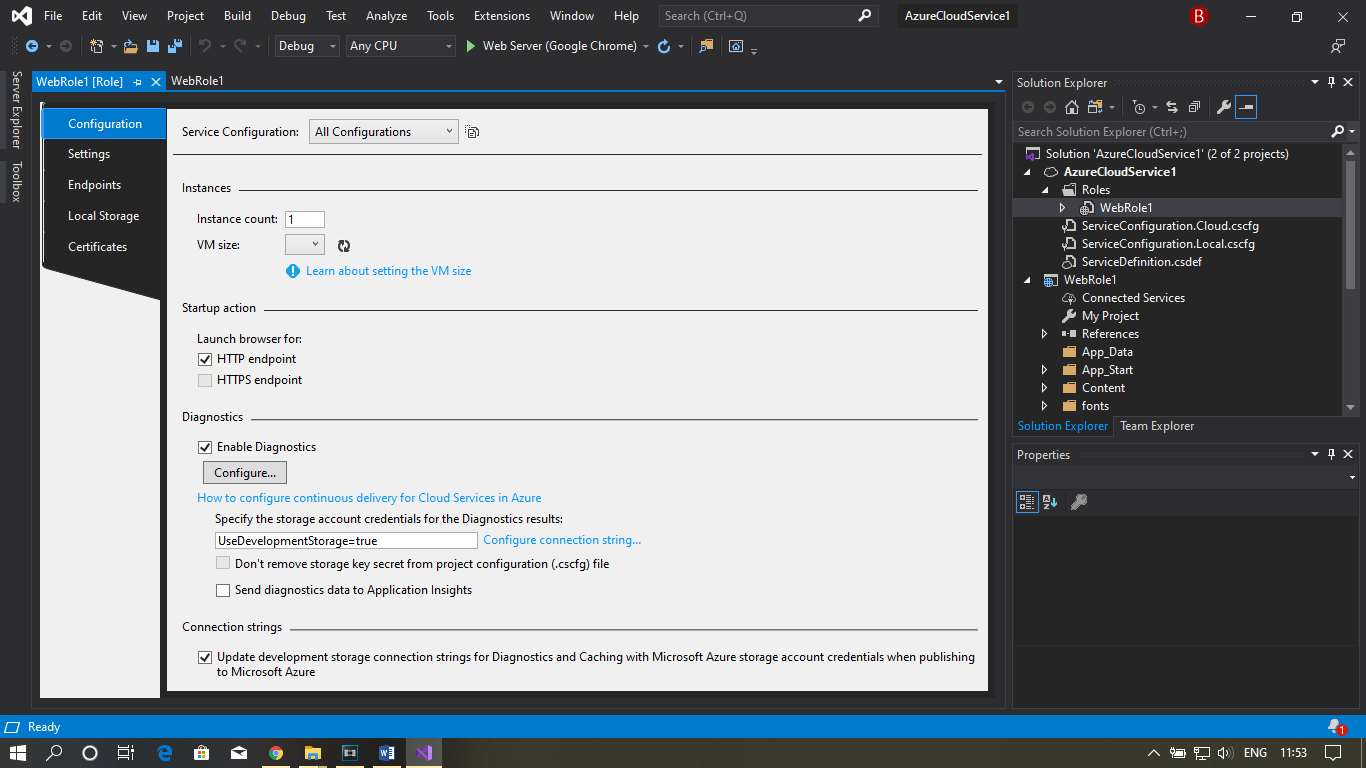
Step 7. To deploy this cloud service to Azure, right-click on the file name and select the "Publish" option.
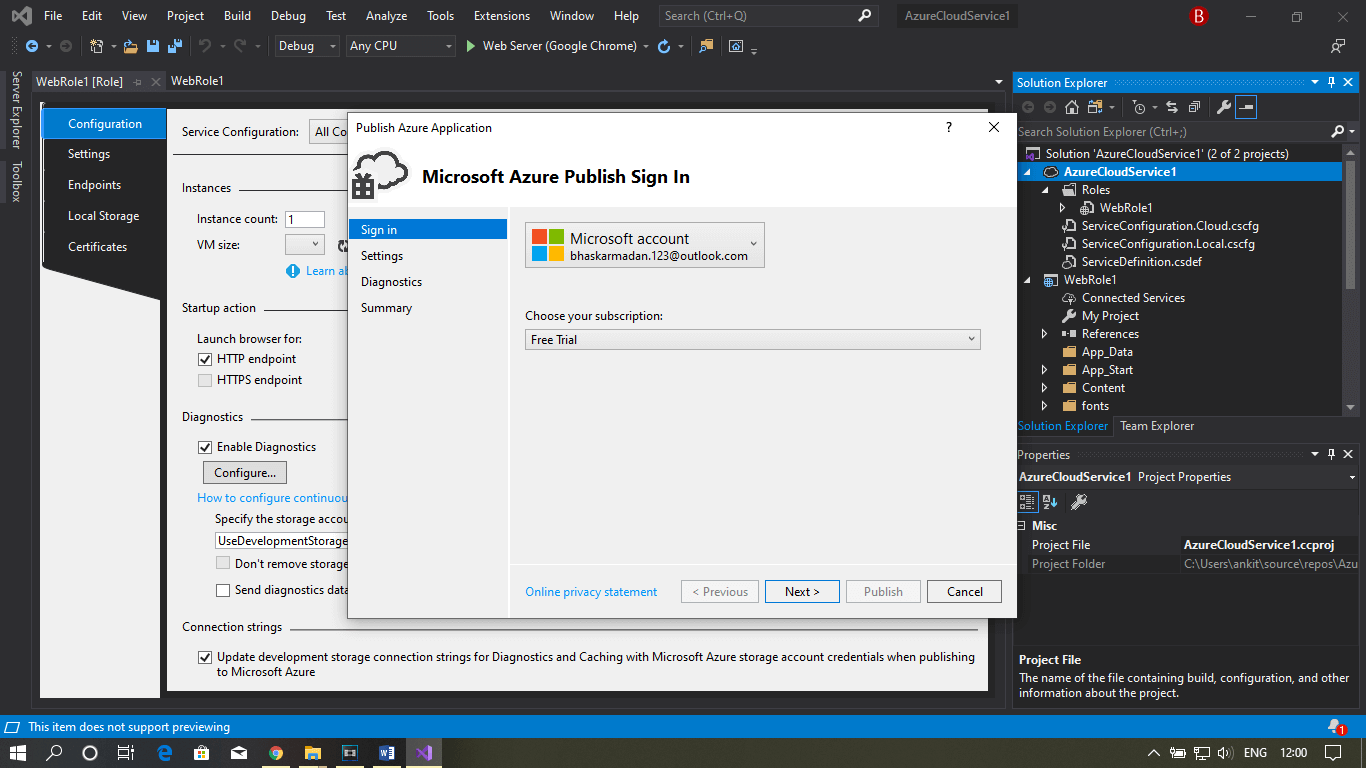
Step 8. Choose your subscription and proceed to the next step.
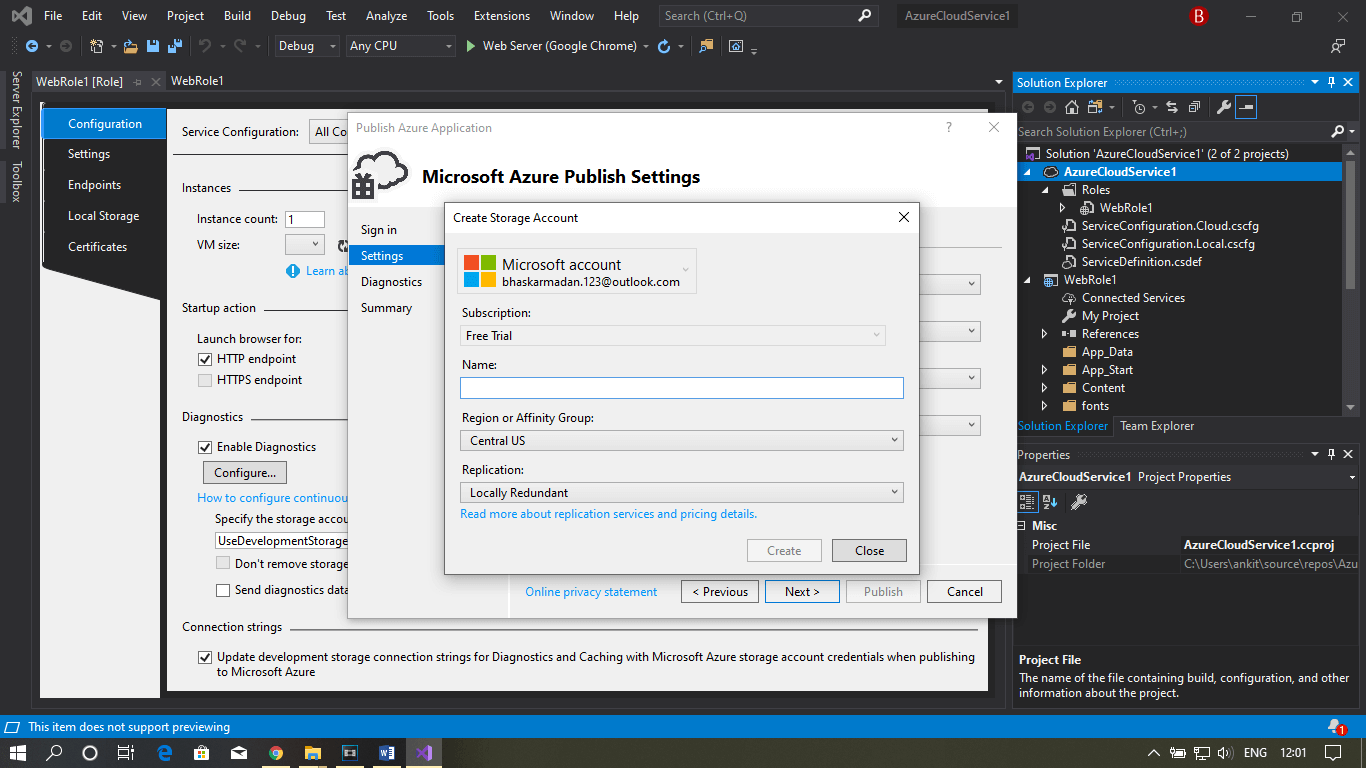
Step 9. Complete all the necessary details and then click on publish.
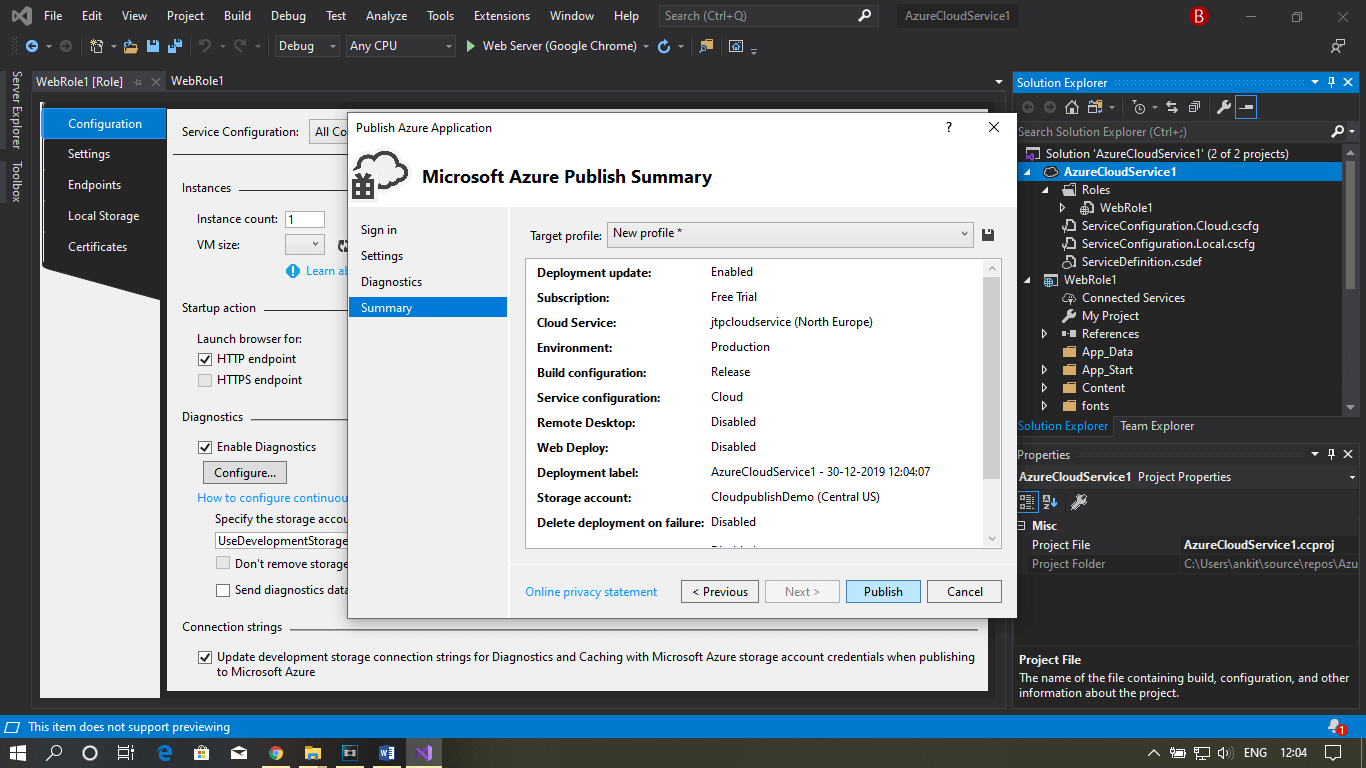
Step 10. Now, open the Azure portal and select the Resource Group you created. You should be able to see your web role published, as illustrated in the figure below.
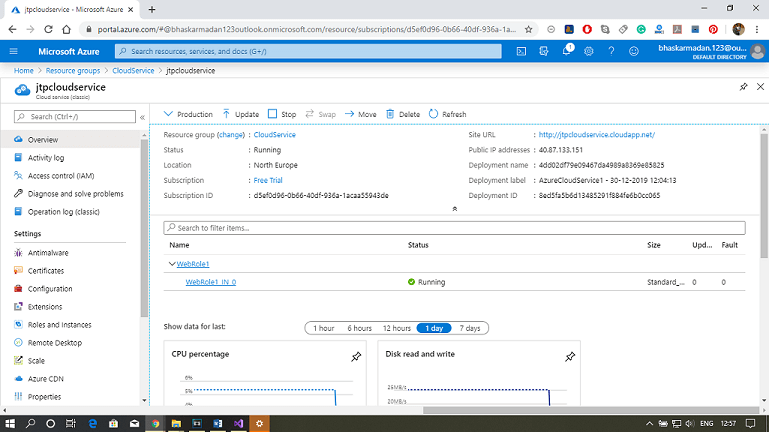
Azure Pricing Model Overview
When using Azure Cloud Services, understanding how pricing works is important so you can manage costs wisely. Azure has a flexible pricing model where you only pay for what you use, which can save money. Here’s a breakdown of how it works:
1. Pay-as-you-go
With Azure Cloud Services, you only pay for the resources you actually use. For example, if you use virtual machines, you pay based on the hours they run. This means you don’t have to pay for anything you’re not actively using.
2. Subscription-Based
You can sign up for a subscription with Azure Cloud Services, which gives you access to a wide range of tools and resources. You’ll get billed monthly based on your usage, and you can choose different plans depending on your needs.
3. Free Tier
Azure Cloud Services offers a free tier with limited resources. This is great if you’re just learning or experimenting, as you can get started without worrying about costs. You can use basic services, like small virtual machines, for free.
4. Azure Pricing Calculator
Azure provides a pricing calculator to help you estimate costs. You can use it to figure out how much different services will cost based on your planned usage. This makes it easier to avoid surprises in your bill.
5. Reserved Instances
If you know you'll need certain services for a long time, you can reserve them in advance. By doing this, Azure Cloud Services offers discounted rates compared to the pay-as-you-go model, which can save you money in the long run.
The pricing model of Azure Cloud Services gives you flexibility and control, allowing you to only pay for what you use and choose the best plan for your needs.
Why Choose Scholarhat for Azure Certifications?
ScholarHat provides expert-led training for Azure certifications, ensuring you gain in-demand cloud skills for career growth. These certifications validate your expertise in Microsoft Azure, boosting job prospects and industry recognition.
Certifications and Training Courses | Links |
| Azure AI Engineer Certification Training | Click Here |
| Azure Cloud DevOps Engineer Certification Training | Click Here |
| Azure Developer Certification Training | AZ-204 Certification | Click Here |
| Azure AI/ML and GenAI Engineer Certification Training Program | Click Here |
Security in Azure Cloud Services
Security is a top priority in Azure Cloud Services, ensuring that your data and applications are safe from threats. Azure provides multiple layers of protection so you can trust the platform with your sensitive information. Here's how Azure Cloud Services ensures security:
- Encryption: Azure Cloud Services uses encryption to protect your data both when it’s stored and while it's being transferred. This means that even if someone tries to access your data, it’s unreadable without the proper key.
- Identity and Access Management: With Azure Active Directory, Azure Cloud Services helps manage who can access your resources. You can set up permissions and roles to make sure only authorized users can get to specific data or applications.
- Network Security: Azure provides tools like Virtual Networks and Firewalls to keep your resources safe. These features ensure that only trusted users and devices can connect to your Azure Cloud Services environment.
- Compliance and Certifications: Azure Cloud Services complies with various industry standards and certifications (like ISO 27001, GDPR, and HIPAA). This helps businesses meet security and privacy regulations, ensuring that your data stays protected.
Azure Cloud Services has strong security measures in place, giving you peace of mind as you build, deploy, and manage your applications in the cloud.
Azure Cloud Service Vs. AWS Vs. Google Cloud
Here’s a brief comparison between Azure Cloud Services, AWS, and Google Cloud to give you a clearer understanding of their differences:
| Feature | Azure Cloud Services | AWS | Google Cloud |
| Market Share | Azure is a strong player, often favored by enterprises and those using Microsoft tools. | AWS has the largest market share, offering a broad range of services. | Google Cloud is growing but has a smaller market share compared to Azure and AWS. |
| Integration with Other Services | Great integration with Microsoft products like Office 365 and Windows Server. | AWS integrates well with a wide range of tools but lacks deep ties with specific software. | Google Cloud is best for integrating with Google’s services like Gmail and Google Workspace. |
| Pricing | Flexible pricing with pay-as-you-go and reserved options. | Pricing is flexible but can be complex, with lots of options. | Offers competitive pricing with cost-saving tools, like sustained-use discounts. |
| Ease of Use | User-friendly, especially for those familiar with Microsoft tools. | AWS can be overwhelming with its wide range of services, but it offers powerful tools. | Google Cloud is simple to use, with a clean interface and good documentation. |
| Global Reach | Azure has a vast network of data centers worldwide. | AWS has the most extensive global reach with the largest number of data centers. | Google Cloud has a smaller global reach but continues to expand. |
| Security | Strong security features, including encryption and compliance with global standards. | AWS provides strong security, but its complexity can make it harder to manage. | Google Cloud offers robust security with a focus on privacy and data protection. |
| Special Features | Excellent for hybrid cloud setups, integrating with on-premise solutions. | Known for its wide range of services and scalability. | Google Cloud is often favored for AI, machine learning, and big data analytics. |
Advantages of Using Azure Cloud Services
Here are some of the main benefits of using Azure Cloud Services:
- Scalability: With Azure Cloud Services, you can easily scale your resources up or down based on your needs, saving you money and effort.
- Security: Azure Cloud Services provides strong security, including data encryption and secure access controls to protect your data.
- Cost-Effective: You only pay for the services you use, making Azure Cloud Services an affordable choice for both small and large projects.
- Global Reach: Azure has data centers around the world, allowing you to deliver faster and more reliable services to users anywhere.
- Integration: Azure Cloud Services integrates well with other Microsoft products, like Office 365, making it easy to connect your apps and data.
- Reliability: Azure offers high availability and redundancy, ensuring that your applications run smoothly with minimal downtime.
- Easy Management: Azure provides a user-friendly interface and tools for managing your resources, making it easier to monitor and control your cloud environment.
Azure Cloud Services gives you flexibility, security, and tools to grow your business or projects in the cloud with ease.
Common Challenges or Limitations of Azure Cloud Services
While Azure Cloud Services offers many benefits, there are some challenges to be aware of:
- Complex Pricing: Understanding the pricing model of Azure Cloud Services can be tricky, especially for beginners. The different pricing options might be overwhelming at first.
- Learning Curve: Azure Cloud Services has a lot of features, and it can take time to learn how to use everything effectively, especially for new users.
- Limited Support for Non-Microsoft Tools: While Azure works well with Microsoft products, it may not integrate as smoothly with non-Microsoft tools and services.
- Downtime Risk: Although rare, there can be occasional service interruptions or outages in Azure Cloud Services, affecting your applications or data.
- Data Transfer Costs: Moving large amounts of data in and out of Azure Cloud Services can become costly, especially for businesses with high data usage.
These challenges can be managed with careful planning and understanding of how Azure Cloud Services work.
Real-World Use Cases of Azure Cloud Services
Azure Cloud Services is used in many real-world scenarios to help businesses and developers. Here are some examples:
- Website Hosting: Many companies use Azure Cloud Services to host their websites, benefiting from its scalability and reliability to handle varying levels of traffic.
- Data Storage: Businesses store large amounts of data on Azure, taking advantage of its secure, cost-effective storage solutions like Blob Storage and SQL Database.
- App Development: Developers use Azure Cloud Services to build and deploy applications, leveraging tools like Azure App Services to streamline the process.
- Machine Learning: Azure Cloud Services is also used for AI and machine learning projects, offering powerful tools to build and train models on large datasets.
These are just a few ways Azure Cloud Services helps companies and individuals achieve their goals in the cloud.
Future of Azure Cloud Services
Azure Cloud Services is set to grow and evolve, offering more advanced features and capabilities. As businesses and technology continue to change, Azure will adapt to meet new demands and provide better solutions for its users.
- Expansion of AI and Machine Learning: Azure Cloud Services will continue to improve AI and machine learning capabilities, helping businesses unlock new opportunities.
- Increased Integration with Edge Computing: Azure Cloud Services will expand its support for edge computing, allowing faster data processing on local devices.
- Improved Security: As security is always a priority, Azure Cloud Services will focus on providing even stronger protection against emerging threats.
- Growth in Hybrid Cloud Solutions: Azure Cloud Services will grow in hybrid cloud environments, enabling businesses to combine on-premise and cloud resources seamlessly.
Azure Cloud Services is set to become even more essential as it adapts to meet the future needs of businesses and developers.
Conclusion
In conclusion, Azure Cloud Services is a powerful and flexible platform that helps businesses and developers manage their data, applications, and resources in the cloud. With its security features, scalability, and integration with Microsoft tools, Azure Cloud Services is a great choice for organizations of all sizes. As it continues to evolve, Azure will play an even bigger role in shaping the future of cloud computing, offering more innovative solutions to meet the growing needs of users worldwide.
The tech industry is shifting, 70% of developers without cloud skills will struggle by 2026. Join our Microsoft Azure Developer Certification course now!
Test your Skills by Taking the following MCQs
Test your knowledge with these multiple-choice questions and improve your understanding of Azure Cloud Services. Select the correct answers to gauge your progress and learn along the way!
Q 1: What is the primary role of an Azure Cloud Engineer?
FAQs
- Web Role – Handles HTTP/HTTPS requests (e.g., web applications).
- Worker Role – Runs background processes (e.g., data processing, batch jobs).
Take our Azure skill challenge to evaluate yourself!

In less than 5 minutes, with our skill challenge, you can identify your knowledge gaps and strengths in a given skill.









